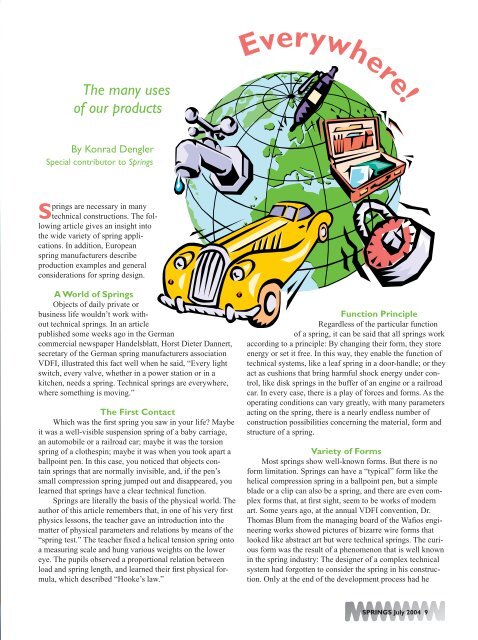Where are Springs Used? - Spring Manufacturers Institute
Where are Springs Used? - Spring Manufacturers Institute
Where are Springs Used? - Spring Manufacturers Institute
Create successful ePaper yourself
Turn your PDF publications into a flip-book with our unique Google optimized e-Paper software.
The many uses<br />
of our products<br />
By Konrad Dengler<br />
Special contributor to <strong><strong>Spring</strong>s</strong><br />
<strong><strong>Spring</strong>s</strong> <strong>are</strong> necessary in many<br />
technical constructions. The following<br />
article gives an insight into<br />
the wide variety of spring applications.<br />
In addition, European<br />
spring manufacturers describe<br />
production examples and general<br />
considerations for spring design.<br />
A World of <strong><strong>Spring</strong>s</strong><br />
Objects of daily private or<br />
business life wouldn’t work without<br />
technical springs. In an article<br />
published some weeks ago in the German<br />
commercial newspaper Handelsblatt, Horst Dieter Dannert,<br />
secretary of the German spring manufacturers association<br />
VDFI, illustrated this fact well when he said, “Every light<br />
switch, every valve, whether in a power station or in a<br />
kitchen, needs a spring. Technical springs <strong>are</strong> everywhere,<br />
where something is moving.”<br />
The First Contact<br />
Which was the fi rst spring you saw in your life? Maybe<br />
it was a well-visible suspension spring of a baby carriage,<br />
an automobile or a railroad car; maybe it was the torsion<br />
spring of a clothespin; maybe it was when you took apart a<br />
ballpoint pen. In this case, you noticed that objects contain<br />
springs that <strong>are</strong> normally invisible, and, if the pen’s<br />
small compression spring jumped out and disappe<strong>are</strong>d, you<br />
learned that springs have a clear technical function.<br />
<strong><strong>Spring</strong>s</strong> <strong>are</strong> literally the basis of the physical world. The<br />
author of this article remembers that, in one of his very fi rst<br />
physics lessons, the teacher gave an introduction into the<br />
matter of physical parameters and relations by means of the<br />
“spring test.” The teacher fi xed a helical tension spring onto<br />
a measuring scale and hung various weights on the lower<br />
eye. The pupils observed a proportional relation between<br />
load and spring length, and learned their fi rst physical formula,<br />
which described “Hooke’s law.”<br />
Everywhere!<br />
Function Principle<br />
Regardless of the particular function<br />
of a spring, it can be said that all springs work<br />
according to a principle: By changing their form, they store<br />
energy or set it free. In this way, they enable the function of<br />
technical systems, like a leaf spring in a door-handle; or they<br />
act as cushions that bring harmful shock energy under control,<br />
like disk springs in the buffer of an engine or a railroad<br />
car. In every case, there is a play of forces and forms. As the<br />
operating conditions can vary greatly, with many parameters<br />
acting on the spring, there is a nearly endless number of<br />
construction possibilities concerning the material, form and<br />
structure of a spring.<br />
Variety of Forms<br />
Most springs show well-known forms. But there is no<br />
form limitation. <strong><strong>Spring</strong>s</strong> can have a “typical” form like the<br />
helical compression spring in a ballpoint pen, but a simple<br />
blade or a clip can also be a spring, and there <strong>are</strong> even complex<br />
forms that, at fi rst sight, seem to be works of modern<br />
art. Some years ago, at the annual VDFI convention, Dr.<br />
Thomas Blum from the managing board of the Wafi os engineering<br />
works showed pictures of bizarre wire forms that<br />
looked like abstract art but were technical springs. The curious<br />
form was the result of a phenomenon that is well known<br />
in the spring industry: The designer of a complex technical<br />
system had forgotten to consider the spring in his construction.<br />
Only at the end of the development process had he<br />
SPRINGS July 2004 9





